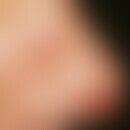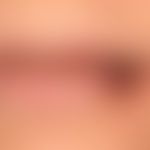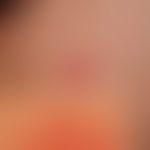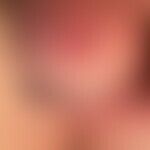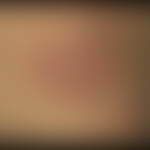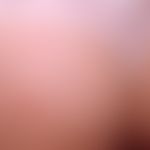Synonym(s)
DefinitionThis section has been translated automatically.
Most frequent clinical manifestation of a herpes simplex virus infection (the initial infections are often clinically inapparent. This is particularly true for HSV-2 initial infection in the genital area) on the skin or mucous membrane in the form of eruptions, usually chronic recurrent eruptions of grouped standing vesicles the size of a pinhead.
PathogenThis section has been translated automatically.
Herpes simplex virus. HSV-1; HSV-2; the proportion of HSV-2 positive virus carriers has increased significantly in recent years. In Western Europe it amounts to about 20%.
You might also be interested in
EtiopathogenesisThis section has been translated automatically.
Provoking factors of recurrence of herpes simplex infections are febrile infections, UV exposure, mental and physical stress, local trauma, menstruation.
LocalizationThis section has been translated automatically.
- Localized:
- Lip (most common localization): Herpes labialis
- Face: Herpes facialis (herpes gladiatorum)
- Eye: Keratoconjunctivitis herpetica
- Genital area: Genital herpes (herpes simplex progenitalis)
- Other localizations: cheek, buttocks; perianal area; fingers. In rare cases, especially in immunosuppressed patients, visceral organs (oesophagus, lungs, liver, CNS).
- Generalized skin infestation:
ClinicThis section has been translated automatically.
Prodromes in the form of itching, a feeling of tension, possibly pain and varying degrees of local swelling, e.g. lip swelling in herpes labialis.
Grouped, standing, partially confluent, bulging, pinhead-sized blisters appear on a reddened background.
The size of the entire skin lesion is usually 0.5-2.0 cm, the border is polycyclic.
Purulent clouding of the blisters within 2-4 days, honey-yellow crusts remain after bursting. Healing after approx. 1 week, usually without scars.
After severe infections, small, indented scars may remain.
Often accompanied by painful regional lymphadenopathy.
Recurrences often occur in individual, very different periods at the same or a neighboring site in the same region(herpes recidivans in loco).
In rare cases (described in immunosuppressed patients), a herpes simplex infection of the skin can also occur as clinically uncharacteristic follicular inflammation "herpes folliculitis".
Immunosuppression: HSV reactivation in this constellation can lead to extensive, poorly healing skin and mucous membrane infections, possible extracutaneous organ infestation (visceral herpes infections: liver, oesophagus, lungs, brain).
Psychological stress - acute or chronic - with accompanying immunosuppression
HistologyThis section has been translated automatically.
Differential diagnosisThis section has been translated automatically.
Complication(s)(associated diseasesThis section has been translated automatically.
- grafted pyoderma in loco.
- Formation of poorly healing ulcers or haemorrhages with underlying immune deficiency.
- in case of severe immunodeficiency extracutaneous organ infestation possible. Potentially lethal herpes encephalitis is rare.
- After frequent recurrences over many years, the development of secondary lymphedema is possible ( Elephantiasis nostras).
TherapyThis section has been translated automatically.
Internal therapyThis section has been translated automatically.
- In cases of extensive complicated herpes simplex, internal treatment with acyclovir i.v. (5 mg/kg bw/day) is recommended until the blisters have healed (approx. 5 days).
- In HIV-infected patients increase the acyclovir dosage (10 (max. 20) mg/kg bw/day).
- Alternatively Famciclovir p.o. (e.g. Famvir Filmtbl.) 3 times/day 250 mg or Valaciclovir (Valtrex Filmtbl.) 3 times/day 1000 mg p.o.
- In case of therapy failure Foscarnet (Foscavir Astra) 3 times/day 40-60 mg/kg bw/day i.v. in 500 NaCl over 2 hours
Progression/forecastThis section has been translated automatically.
In contrast to the often unnoticed primary infection , recurrent HSV infection is a frequent, usually unspectacular clinical event (Note: the initial infection can also occur, usually in childhood, as clinically severe gingivostomatitis herpetica!) The number of recurrences varies considerably intraindividually, from a few periods of infection in life, 3-4 per year (this is the most common period), to monthly or bimonthly episodes.
ProphylaxisThis section has been translated automatically.
- Avoid known trigger factors (e.g. excessive UV exposure; when skiing in high mountains, the use of physical sun protection with the highest sun protection factor is recommended)
- If a recurrence occurs, the general hygiene measures (hand disinfection) must be observed
- Direct skin contact with a herpes lesion should be avoided
- At the first signs of a recurrence, consistent "anti-herpetic" local therapy
- Commonly used methods such as toothpaste, alcohol or vinegar are of little help.
- If there is a high incidence of recurrence, long-term systemic therapy should be considered.
- Lysine in a lower dosage is suitable for the prophylaxis of recurrent herpes simplex. Available as lysine capsules (500 mg) or Lyranda® as a ready-to-use preparation.
- Exploration of psychological trigger factors and the corresponding treatment/prevention strategies
NaturopathyThis section has been translated automatically.
Local therapy: Good results have been described in a randomized, double-blind, placebo-controlled clinical trial in 66 patients with a balm cream (4 times/day for 5 days) (see below phytotherapy, see below lemon balm).
Phytotherapy externalThis section has been translated automatically.
Good results have been described in a randomized, double-blind, placebo-controlled clinical trial on 66 patients with a balm cream (4 times/day for 5 days) (see below phytotherapy, see below lemon balm).
Phytotherapy internalThis section has been translated automatically.
Phytotherapeutically, in the case of recurrent herpes simplex, a fixed combination of dyer's pod root, arborvitae tips and echinacea roots as contained in Esberitox N (dosage: 3-3-3 tbl/day) can be used.
Systemic therapy with echinacea extracts(Echinaceae purpureae herba) is also recommended (Echinacin Liquidum - 1.5-1.5-2.5ml/day).
Good response rates are achieved with the amino acid lysine in a dose of 3 x 500-1000 mg/day during an attack of acute herpes simplex. Commercial preparation for dietary treatment: Lyranda® chewable tablets. In addition to L-lysine, these also contain zinc, selenium, vitamins and bioflavonoids. Recommended dosage until healing: 3 chewable tablets/day.
Case report(s)This section has been translated automatically.
In numerous cases, therapy using intermittent hypoxia hyperoxia (IHHT) has led to a significant strengthening of the immune system through the neogenesis of the mitochondria associated with this therapy, accompanied by a significant remission of the recurrences.
LiteratureThis section has been translated automatically.
Griffith RS et al (1987) Success of L-lysine therapy in frequently recurrent herpes simplex infection. Treatment and prophylaxis. Dermatologica 175: 183-190.
Kimmig W (1989) Herpes simplex infections. Z Hautkr 64: 266-271
- Bracket M et al (2003) Acyclovir-resistant herpes exulcerans et persistens. Type II. dermatologist 54: 362-364
- Koytchev R et al (1999) Balm mint extract (Lo-701) for topical treatment of recurring herpes labialis. Phytomedicine 6: 225-230
- Lautenschläger S (2018) Human herpes viruses. In: G.Plewig et al (Ed.) Braun-Falco`s Dermatology, Venerology and Allergology, Springer Reference Medicine p.103
Long D et al (2014) Identification of novel virus-specific antigens by CD4⁺ and CD8⁺ T cells from asymptomatic HSV-2 seropositive and seronegative donors. Virology 464-465:296-311
McCarthy KJ et al (2019) Hormonal Contraceptives and the Acquisition of Sexually Transmitted Infections: An Updated Systematic Review. Sex Transm Dis 46:290-296
- Simmons A (2002) Clinical manifestations and treatment considerations of herpes simplex virus infection. J Infect Dis 186: S71-77
Incoming links (23)
Aciclovir; Anal fissure; Cheilitis granulomatosa; Chronic lymphocytic leukemia; Cold sore; Disgusting blisters; Elephantiasis nostras; Elephantiasis nostras; Facial swelling, differential diagnosis; Herpes folliculitis; ... Show allOutgoing links (23)
Aciclovir; Acutal ulcer; Contagious impetigo; Echinacea purpurea herba; Eczema herpeticum; Elephantiasis nostras; Famciclovir; Foscarnet; Genital herpes; Gingivostomatitis herpetica; ... Show allDisclaimer
Please ask your physician for a reliable diagnosis. This website is only meant as a reference.


